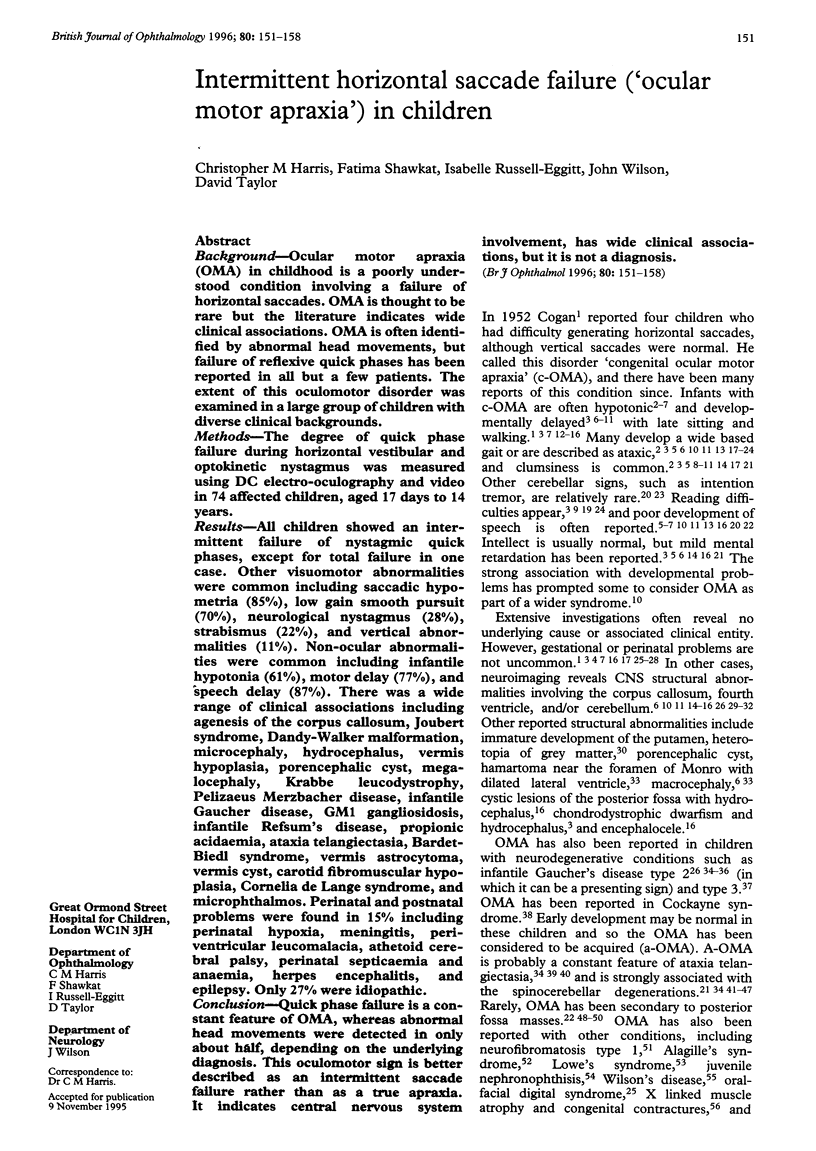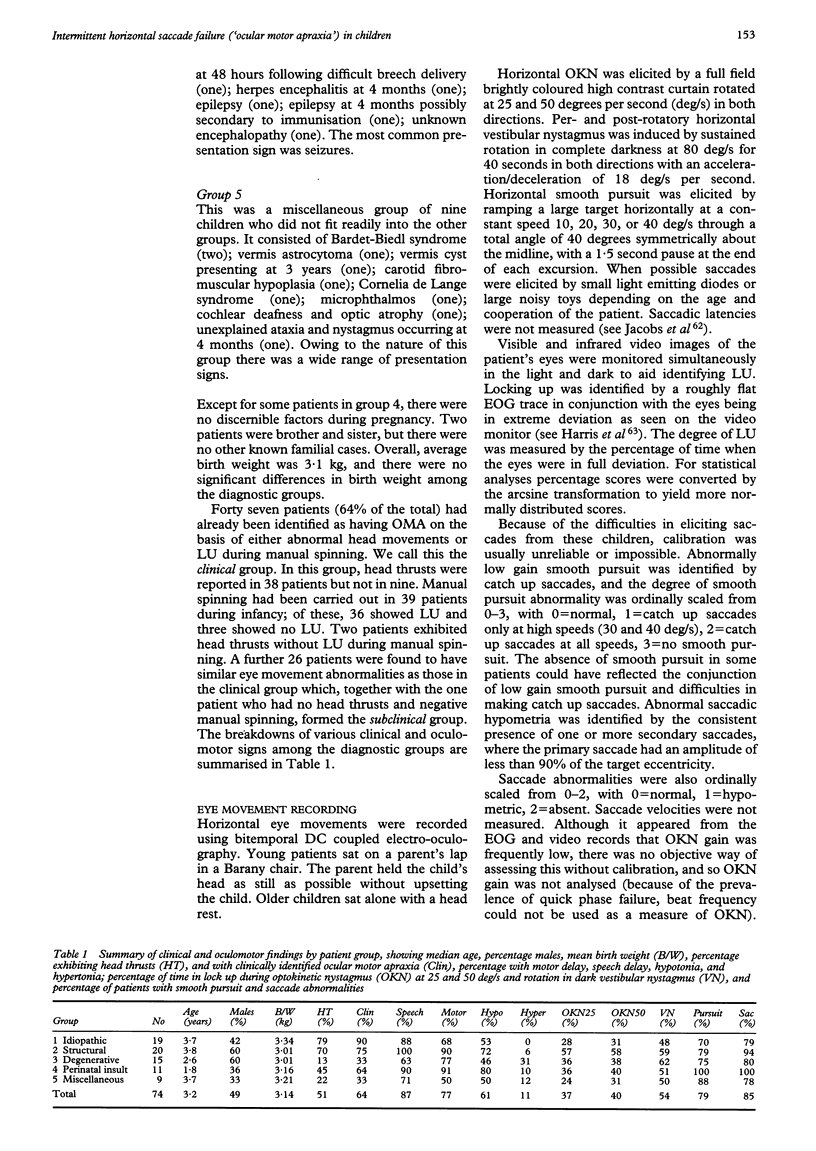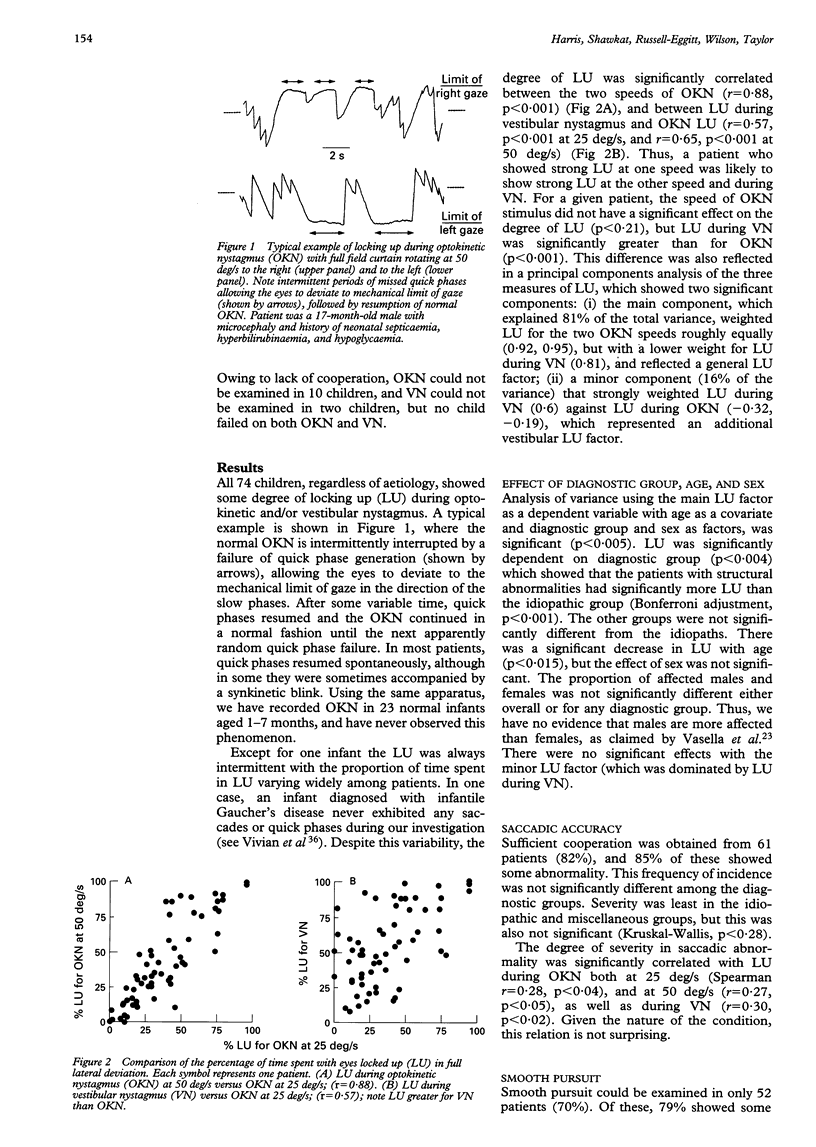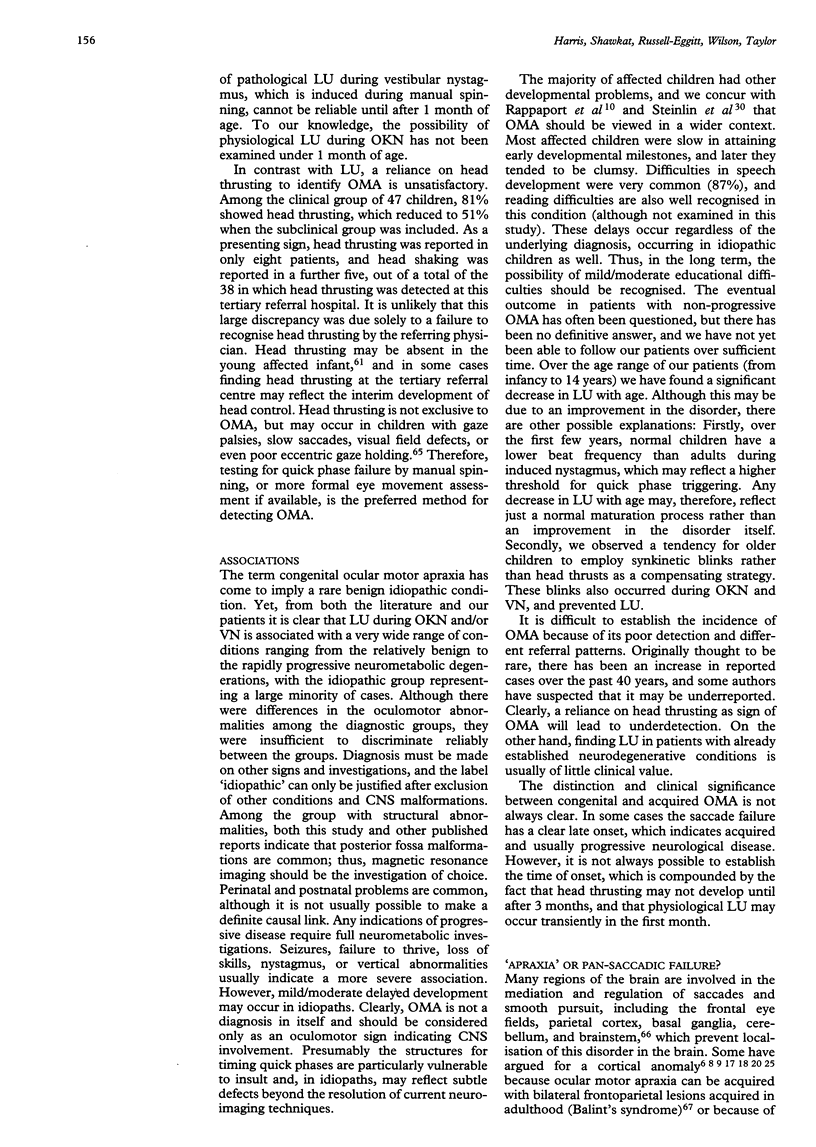Abstract
BACKGROUND: Ocular motor apraxia (OMA) in childhood is a poorly understood condition involving a failure of horizontal saccades. OMA is thought to be rare but the literature indicates wide clinical associations. OMA is often identified by abnormal head movements, but failure of reflexive quick phases has been reported in all but a few patients. The extent of this oculomotor disorder was examined in a large group of children with diverse clinical backgrounds. METHODS: The degree of quick phase failure during horizontal vestibular and optokinetic nystagmus was measured using DC electro-oculography and video in 74 affected children, aged 17 days to 14 years. RESULTS: All children showed an intermittent failure of nystagmic quick phases, except for total failure in one case. Other visuomotor abnormalities were common including saccadic hypometria (85%), low gain smooth pursuit (70%), neurological nystagmus (28%), strabismus (22%), and vertical abnormalities (11%). Non-ocular abnormalities were common including infantile hypotonia (61%), motor delay (77%), and speech delay (87%). There was a wide range of clinical associations including agenesis of the corpus callosum, Joubert syndrome, Dandy-Walker malformation, microcephaly, hydrocephalus, vermis hypoplasia, porencephalic cyst, megalocephaly, Krabbe leucodystrophy, Pelizaeus Merzbacher disease, infantile Gaucher disease, GM1 gangliosidosis, infantile Refsum's disease, propionic acidaemia, ataxia telangiectasia, Bardet-Biedl syndrome, vermis astrocytoma, vermis cyst, carotid fibromuscular hypoplasia, Cornelia de Lange syndrome, and microphthalmos. Perinatal and postnatal problems were found in 15% including perinatal hypoxia, meningitis, periventricular leucomalacia, athetoid cerebral palsy, perinatal septicaemia and anaemia, herpes encephalitis, and epilepsy. Only 27% were idiopathic. CONCLUSION: Quick phase failure is a constant feature of OMA, whereas abnormal head movements were detected in only about half, depending on the underlying diagnosis. This oculomotor sign is better described as an intermittent saccade failure rather than as a true apraxia. It indicates central nervous system involvement, has wide clinical associations, but it is not a diagnosis.
Full text
PDF







Selected References
These references are in PubMed. This may not be the complete list of references from this article.
- ALTROCCHI P. H., MENKES J. H. Congenital ocular motor apraxia. Brain. 1960 Dec;83:579–588. doi: 10.1093/brain/83.4.579. [DOI] [PubMed] [Google Scholar]
- Aicardi J., Barbosa C., Andermann E., Andermann F., Morcos R., Ghanem Q., Fukuyama Y., Awaya Y., Moe P. Ataxia-ocular motor apraxia: a syndrome mimicking ataxia-telangiectasia. Ann Neurol. 1988 Oct;24(4):497–502. doi: 10.1002/ana.410240404. [DOI] [PubMed] [Google Scholar]
- Alvarez F., Landrieu P., Laget P., Lemonnier F., Odièvre M., Alagille D. Nervous and ocular disorders in children with cholestasis and vitamin A and E deficiencies. Hepatology. 1983 May-Jun;3(3):410–414. doi: 10.1002/hep.1840030321. [DOI] [PubMed] [Google Scholar]
- Avanzini G., Girotti F., Caraceni T., Spreafico R. Oculomotor disorders in Huntington's chorea. J Neurol Neurosurg Psychiatry. 1979 Jul;42(7):581–589. doi: 10.1136/jnnp.42.7.581. [DOI] [PMC free article] [PubMed] [Google Scholar]
- Borchert M. S., Sadun A. A., Sommers J. D., Wright K. W. Congenital ocular motor apraxia in twins. Findings with magnetic resonance imaging. J Clin Neuroophthalmol. 1987 Jun;7(2):104–107. [PubMed] [Google Scholar]
- CAMPBELL W. L., ZELLER R. Congenital ocular motor apraxia in females. Arch Ophthalmol. 1961 Nov;66:643–645. doi: 10.1001/archopht.1961.00960010645007. [DOI] [PubMed] [Google Scholar]
- COGAN D. G. A type of congenital ocular motor apraxia presenting jerky head movements. Trans Am Acad Ophthalmol Otolaryngol. 1952 Nov-Dec;56(6):853–862. [PubMed] [Google Scholar]
- Catalano R. A., Calhoun J. H., Reinecke R. D., Cogan D. G. Asymmetry in congenital ocular motor apraxia. Can J Ophthalmol. 1988 Dec;23(7):318–321. [PubMed] [Google Scholar]
- Cogan D. G., Chu F. C., Reingold D., Barranger J. Ocular motor signs in some metabolic diseases. Arch Ophthalmol. 1981 Oct;99(10):1802–1808. doi: 10.1001/archopht.1981.03930020676010. [DOI] [PubMed] [Google Scholar]
- Cogan D. G. Congenital ocular motor apraxia. Can J Ophthalmol. 1966 Oct;1(4):253–260. [PubMed] [Google Scholar]
- Cogan D. G. Heredity of congenital ocular motor apraxia. Trans Am Acad Ophthalmol Otolaryngol. 1972 Jan-Feb;76(1):60–63. [PubMed] [Google Scholar]
- Donaldson M. D., Warner A. A., Trompeter R. S., Haycock G. B., Chantler C. Familial juvenile nephronophthisis, Jeune's syndrome, and associated disorders. Arch Dis Child. 1985 May;60(5):426–434. doi: 10.1136/adc.60.5.426. [DOI] [PMC free article] [PubMed] [Google Scholar]
- Eda I., Takashima S., Kitahara T., Ohno K., Takeshita K. Computed tomography in congenital ocular motor apraxia. Neuroradiology. 1984;26(5):359–362. doi: 10.1007/BF00327487. [DOI] [PubMed] [Google Scholar]
- Ferrer I., Fernández Alvarez E., González A., Pineda M. Apraxia oculomotora congénita. A propóstio de cuatro observaciones. Rev Clin Esp. 1979 Jun 30;153(6):471–473. [PubMed] [Google Scholar]
- Fielder A. R., Gresty M. A., Dodd K. L., Mellor D. H., Levene M. I. Congenital ocular motor apraxia. Trans Ophthalmol Soc U K. 1986;105(Pt 5):589–598. [PubMed] [Google Scholar]
- Gittinger J. W., Jr, Sokol S. The visual-evoked potential in the diagnosis of congenital ocular motor apraxia. Am J Ophthalmol. 1982 Jun;93(6):700–703. doi: 10.1016/0002-9394(82)90462-7. [DOI] [PubMed] [Google Scholar]
- Glover A. T., Powe L. K. Ocular motor apraxia and neurofibromatosis. Arch Ophthalmol. 1985 Jun;103(6):763–763. doi: 10.1001/archopht.1985.01050060021008. [DOI] [PubMed] [Google Scholar]
- Harris C. M., Kriss A., Shawkat F., Taylor D. The use of video in assessing and illustrating abnormal eye movements in young children. J Audiov Media Med. 1992 Jul;15(3):113–116. doi: 10.3109/17453059209018364. [DOI] [PubMed] [Google Scholar]
- Hausser C. O., Robert F., Giard N. Balint's syndrome. Can J Neurol Sci. 1980 May;7(2):157–161. doi: 10.1017/s0317167100023544. [DOI] [PubMed] [Google Scholar]
- ISRAELS S., REED H. Congenital ocular motor apraxia, a form of horizontal gaze palsy. Br J Ophthalmol. 1956 Jul;40(7):444–448. doi: 10.1136/bjo.40.7.444. [DOI] [PMC free article] [PubMed] [Google Scholar]
- Jacobs M., Harris C., Shawkat F., Taylor D. The objective assessment of abnormal eye movements in infants and young children. Aust N Z J Ophthalmol. 1992 Aug;20(3):185–195. doi: 10.1111/j.1442-9071.1992.tb00938.x. [DOI] [PubMed] [Google Scholar]
- Johnston J. L., Sharpe J. A., Morrow M. J. Spasm of fixation: a quantitative study. J Neurol Sci. 1992 Feb;107(2):166–171. doi: 10.1016/0022-510x(92)90285-s. [DOI] [PubMed] [Google Scholar]
- KEINER G. B., KEINER E. C. Congenital ocular motor apraxia: report of a case in an adult male. Am J Ophthalmol. 1958 Sep;46(3 Pt 1):382–385. [PubMed] [Google Scholar]
- Kirkham T. H., Kamin D. F. Slow saccadic eye movements in Wilson's disease. J Neurol Neurosurg Psychiatry. 1974 Feb;37(2):191–194. doi: 10.1136/jnnp.37.2.191. [DOI] [PMC free article] [PubMed] [Google Scholar]
- Koeppen A. H., Hans M. B. Supranuclear ophthalmoplegia in olivopontocerebellar degeneration. Neurology. 1976 Aug;26(8):764–768. doi: 10.1212/wnl.26.8.764. [DOI] [PubMed] [Google Scholar]
- LYLE D. J. A discussion of ocular motor apraxia with a case presentation. Trans Am Ophthalmol Soc. 1961;59:274–285. [PMC free article] [PubMed] [Google Scholar]
- Lacey D. J. Agenesis of the corpus callosum. Clinical features in 40 children. Am J Dis Child. 1985 Sep;139(9):953–955. doi: 10.1001/archpedi.1985.02140110107042. [DOI] [PubMed] [Google Scholar]
- Lambert S. R., Kriss A., Gresty M., Benton S., Taylor D. Joubert syndrome. Arch Ophthalmol. 1989 May;107(5):709–713. doi: 10.1001/archopht.1989.01070010727035. [DOI] [PubMed] [Google Scholar]
- Liu C. H. Cryoextraction of cataracts in high myopes. Eye Ear Nose Throat Mon. 1973 Feb;52(2):53–55. [PubMed] [Google Scholar]
- Manson J. I. Ocular motor apraxia in childhood. Proc Aust Assoc Neurol. 1973;10(0):27–29. [PubMed] [Google Scholar]
- Mayr U. G., Haberfellner H. Congenitale, oculomotorische Apraxie Bericht über einen Fall. Padiatr Padol. 1972;7(2):196–203. [PubMed] [Google Scholar]
- Moore A. T., Taylor D. S. A syndrome of congenital retinal dystrophy and saccade palsy--a subset of Leber's amaurosis. Br J Ophthalmol. 1984 Jun;68(6):421–431. doi: 10.1136/bjo.68.6.421. [DOI] [PMC free article] [PubMed] [Google Scholar]
- Morimoto T., Oguni H., Awaya Y., Hayakawa T., Fukuyama Y. A case of a rapidly progressive central nervous system disorder manifesting as a pallidal posture and ocular motor apraxia. Brain Dev. 1985;7(4):449–453. doi: 10.1016/s0387-7604(85)80146-7. [DOI] [PubMed] [Google Scholar]
- Orrison W. W., Robertson W. C., Jr Congenital ocular motor apraxia. A possible disconnection syndrome. Arch Neurol. 1979 Jan;36(1):29–31. doi: 10.1001/archneur.1979.00500370059013. [DOI] [PubMed] [Google Scholar]
- Patterson M. C., Horowitz M., Abel R. B., Currie J. N., Yu K. T., Kaneski C., Higgins J. J., O'Neill R. R., Fedio P., Pikus A. Isolated horizontal supranuclear gaze palsy as a marker of severe systemic involvement in Gaucher's disease. Neurology. 1993 Oct;43(10):1993–1997. doi: 10.1212/wnl.43.10.1993. [DOI] [PubMed] [Google Scholar]
- PeBenito R., Cracco J. B. Congenital ocular motor apraxia. Case reports and literature review. Clin Pediatr (Phila) 1988 Jan;27(1):27–31. doi: 10.1177/000992288802700105. [DOI] [PubMed] [Google Scholar]
- RIOPEL D. A. Congenital ocular motor apraxia. Report of a case with a review of the literature. Am J Ophthalmol. 1963 Mar;55:511–514. [PubMed] [Google Scholar]
- Rappaport L., Urion D., Strand K., Fulton A. B. Concurrence of congenital ocular motor apraxia and other motor problems: an expanded syndrome. Dev Med Child Neurol. 1987 Feb;29(1):85–90. doi: 10.1111/j.1469-8749.1987.tb02110.x. [DOI] [PubMed] [Google Scholar]
- Rendle-Short J., Appleton B., Pearn J. Congenital ocular motor apraxia: paediatric aspects. Aust Paediatr J. 1973 Oct;9(5):263–268. doi: 10.1111/j.1440-1754.1973.tb02232.x. [DOI] [PubMed] [Google Scholar]
- Robles J. Congenital ocular motor apraxia in identical twins. Arch Ophthalmol. 1966 Jun;75(6):746–749. doi: 10.1001/archopht.1966.00970050748005. [DOI] [PubMed] [Google Scholar]
- Starr A. A disorder of rapid eye movements in Huntington's chorea. Brain. 1967 Sep;90(3):545–564. doi: 10.1093/brain/90.3.545. [DOI] [PubMed] [Google Scholar]
- Stell R., Bronstein A. M., Plant G. T., Harding A. E. Ataxia telangiectasia: a reappraisal of the ocular motor features and their value in the diagnosis of atypical cases. Mov Disord. 1989;4(4):320–329. doi: 10.1002/mds.870040405. [DOI] [PubMed] [Google Scholar]
- Sternberg-Raáb A. Ein Fall von angeborener okulärer motorischer Apraxie. Klin Monbl Augenheilkd. 1965 Oct;147(2):234–240. [PubMed] [Google Scholar]
- Summers C. G., MacDonald J. T., Wirtschafter J. D. Ocular motor apraxia associated with intracranial lipoma. J Pediatr Ophthalmol Strabismus. 1987 Sep-Oct;24(5):267–269. doi: 10.3928/0191-3913-19870901-17. [DOI] [PubMed] [Google Scholar]
- Tripp J. H., Lake B. D., Young E., Ngu J., Brett E. M. Juvenile Gaucher's disease with horizontal gaze palsy in three siblings. J Neurol Neurosurg Psychiatry. 1977 May;40(5):470–478. doi: 10.1136/jnnp.40.5.470. [DOI] [PMC free article] [PubMed] [Google Scholar]
- Vassella F., Lütschg J., Mumenthaler M. Cogan's congenital ocular motor apraxia in two successive generations. Dev Med Child Neurol. 1972 Dec;14(6):788–796. doi: 10.1111/j.1469-8749.1972.tb03322.x. [DOI] [PubMed] [Google Scholar]
- Vercelletto-Friol M., Lavenant F., Bricout J. H., Venisse T., Vercelletto P., Feve J. R. Apraxie oculomotrice congénitale avec agénésie du corps calleux et atrophie sous-tentorielle. Rev Neurol (Paris) 1986;142(2):140–144. [PubMed] [Google Scholar]
- Wadia N. H., Swami R. K. A new form of heredo-familial spinocerebellar degeneration with slow eye movements (nine families). Brain. 1971;94(2):359–374. doi: 10.1093/brain/94.2.359. [DOI] [PubMed] [Google Scholar]
- Weissman B. M., DiScenna A. O., Leigh R. J. Maturation of the vestibulo-ocular reflex in normal infants during the first 2 months of life. Neurology. 1989 Apr;39(4):534–538. doi: 10.1212/wnl.39.4.534. [DOI] [PubMed] [Google Scholar]
- Wieacker P., Wolff G., Wienker T. F., Sauer M. A new X-linked syndrome with muscle atrophy, congenital contractures, and oculomotor apraxia. Am J Med Genet. 1985 Apr;20(4):597–606. doi: 10.1002/ajmg.1320200405. [DOI] [PubMed] [Google Scholar]
- Woods C. G., Taylor A. M. Ataxia telangiectasia in the British Isles: the clinical and laboratory features of 70 affected individuals. Q J Med. 1992 Feb;82(298):169–179. [PubMed] [Google Scholar]
- Wybar K. Disorders of ocular motility in brain stem lesions in children. Ann Ophthalmol. 1971 Jun;3(6):645–passim. [PubMed] [Google Scholar]
- Zaret C. R., Behrens M. M., Eggers H. M. Congenital ocular motor apraxia and brainstem tumor. Arch Ophthalmol. 1980 Feb;98(2):328–330. doi: 10.1001/archopht.1980.01020030324019. [DOI] [PubMed] [Google Scholar]
- Zee D. S., Yee R. D., Singer H. S. Congenital ocular motor apraxia. Brain. 1977 Sep;100(3):581–599. doi: 10.1093/brain/100.3.581. [DOI] [PubMed] [Google Scholar]


